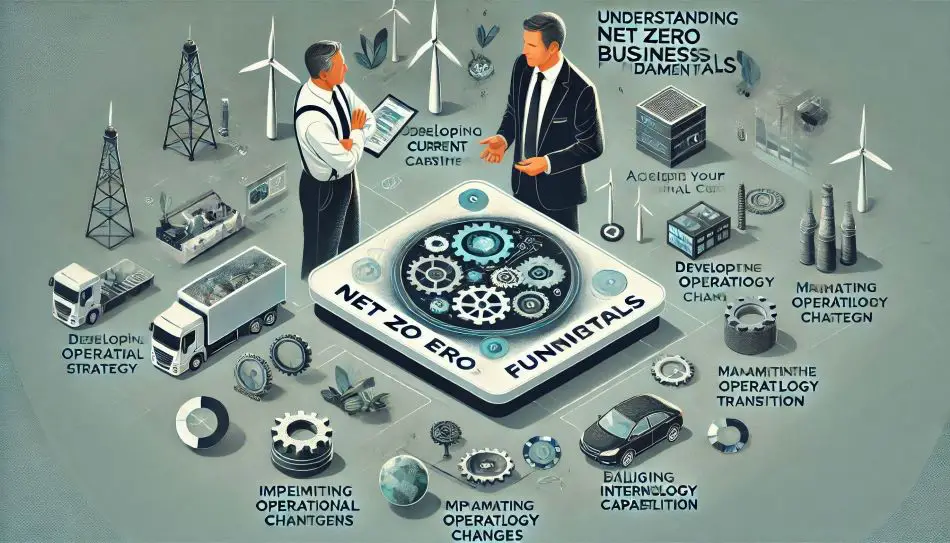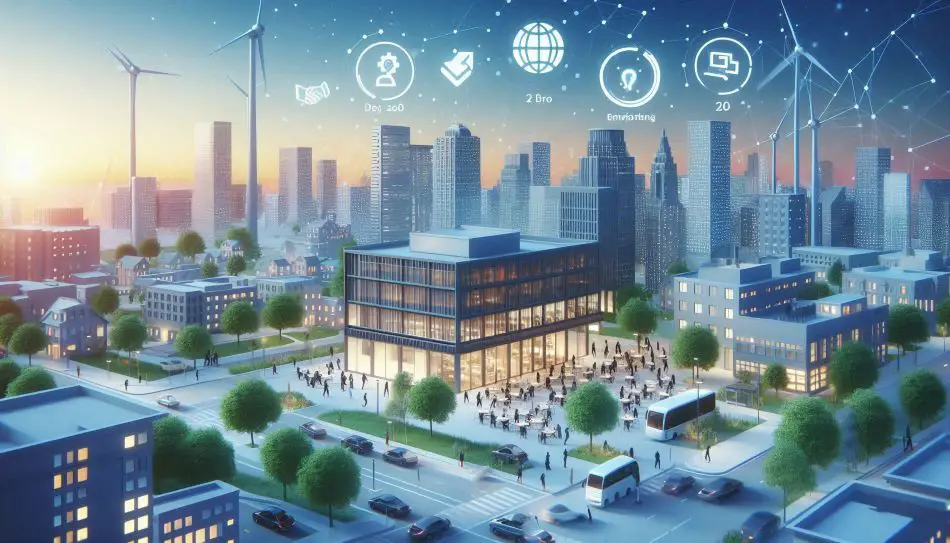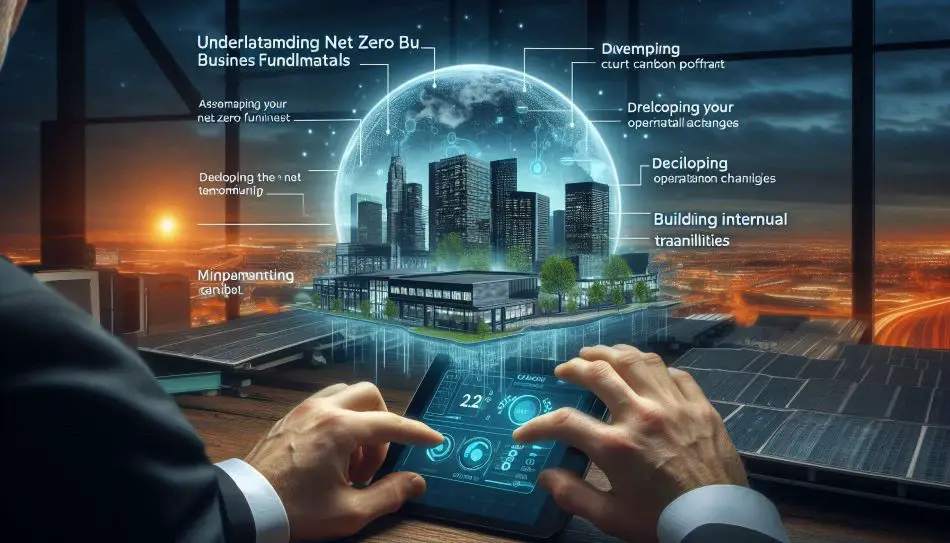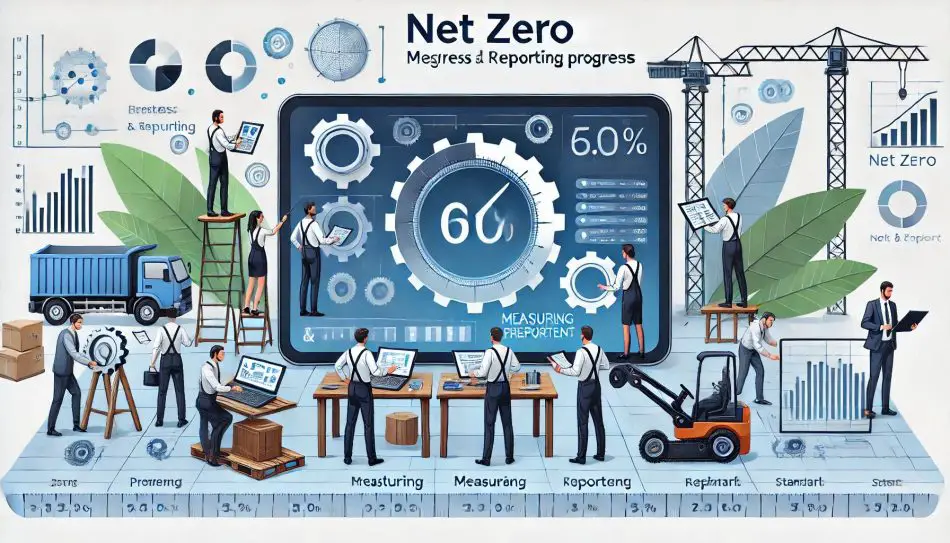Businesses worldwide contribute to 70% of greenhouse gas emissions, making them leading players in climate action responsibility. Companies increasingly pledge carbon neutrality targets, yet they need actionable examples and frameworks to deliver on these promises. This piece offers a detailed net zero strategy example that organizations can customize to start their sustainability experience.
Building a successful net zero business requires multiple steps. The process starts with carbon footprint assessment and extends to strategy implementation. Our framework combines tested carbon neutral approaches with actionable steps toward net zero emissions. The business strategy balances environmental effects with operational efficiency. You will learn the significant ‘how’ of becoming a carbon-neutral enterprise, not just the ‘why’.

Understanding Net Zero Business Fundamentals
Let’s get into the basic ideas that shape a successful net zero business strategy. These principles turn into real actions for organizations that want to achieve carbon neutrality.
Defining Net Zero for Businesses
Net zero means creating a balance between greenhouse gasses added to and removed from the atmosphere 1. This goes beyond just offsetting emissions – businesses need to reshape their operations completely. The Science Based Targets initiative (SBTi) states that businesses must reduce their emissions by 90-95% by 2050. Only the remaining 5-10% can be handled through carbon offsetting 1.
Key Components of Carbon Neutrality
A resilient net zero strategy needs these essential elements:
- Near-term emission targets that match scientific consensus
- Long-term goals to cut carbon (usually 90% or more)
- Ways to remove and store leftover emissions
- Investments beyond the value chain
- Regular tracking and updates on progress 2
Business Benefits and ROI
The evidence shows that net zero strategies lead to great returns. Here are the main benefits:
- Better Market Access: About 450 financial institutions that control 40% of global capital have joined the Glasgow Financial Alliance for Net Zero. Companies with strong climate programs can get capital more easily 3.
- Financial Performance: Companies that follow green practices do better in the stock market than others. Higher ESG scores can cut capital costs by about 10% 3.
- Customer Loyalty: Studies show that 88% of consumers stay more loyal to businesses that support environmental causes 3.
- Risk Protection: Breaking sustainability rules can lead to huge penalties – up to 10 million Euros or 5% of yearly revenue under the Corporate Sustainability Reporting Directive 3.
Net zero makes business sense beyond helping the environment. Market research shows 78% of consumers think a sustainable lifestyle matters 4. This creates new market opportunities. Green practices also help optimize supply chains and lower operating costs through better energy use 4.
Young professionals are changing how companies think about talent. One-third of them (18-24 years) have turned down jobs from companies that don’t care enough about the environment 3. This shows how net zero strategies affect an organization’s success beyond just money.
By 2026, experts predict 60% of public companies will include sustainability in their ROI calculations. About 30% of all debt capital market funding will go toward ESG initiatives 3. These trends show why businesses need complete net zero strategies to succeed in the long run.

Assessing Your Current Carbon Footprint
Starting a journey toward net zero requires a clear picture of your emissions. Let’s look at the quickest way to measure your organization’s carbon footprint with detailed accuracy.
Emissions Measurement Methodologies
Each business has its unique characteristics, and several methodologies help calculate emissions. Here are the most common approaches we use:
- Physical-unit method: Calculates emissions based on actual consumption units like electricity usage in kWh or fuel in liters 5
- Spend-based method: Determines emissions by analyzing financial transactions and purchases 6
- Hybrid method: Combines multiple data sources to give a full picture and provides the most accurate results 5
Data Collection Requirements
Carbon accounting needs data from three main emission scopes. The GHG Protocol states that measurements should include 100% of Scope 1 direct and Scope 2 indirect emissions from operations 7.
Key data requirements include:
- Energy Consumption: Facility-level electricity and fuel usage data
- Vehicle Usage: Company-owned vehicle mileage and fuel consumption
- Fugitive Emissions: Leaks from equipment and processes 7
Accurate measurement depends on quality data through:
- Primary data collection from suppliers where possible
- Quantity data and lifecycle assessments
- Extrapolations and assumptions when needed 8
Setting Your Baseline
Your baseline emissions are the foundations of measuring future progress. A solid baseline typically looks at the last 1-5 years of organizational activity 9. This baseline helps you:
- Measure the success of emission reduction projects
- Determine whether targets are being met
- Create credible strategies for reduction 9
Baseline information enables emissions trading and partnerships between organizations 9. Changes in greenhouse gas volumes compared to this reference point help calculate net reductions during specified reporting periods 9.

Developing Your Net Zero Strategy
The results of our carbon footprint assessment show we need a clear net zero strategy to help our organization achieve carbon neutrality. Our focus will be on creating practical plans that meet scientific requirements.
Setting Science-Based Targets
The first step is to set targets that line up with the Science Based Targets initiative (SBTi) framework. Recent guidelines state businesses must cut emissions in half by 2030 and reach net zero carbon emissions by 2050 10. Two significant target types need to be established:
- Near-term targets: These must be achieved within 5-10 years and cover Scope 1 and 2 emissions. If Scope 3 makes up more than 40% of emissions, we must include two-thirds of these emissions in our near-term targets 10.
- Long-term targets: These goals extend to 2050 or sooner and cover 95% of both Scope 1-2 and Scope 3 emissions 10.
Identifying Priority Areas
Several key areas offer the greatest potential to reduce emissions:
- Energy efficiency and renewable transition
- Supply chain optimization
- Waste reduction protocols
- Transportation and logistics
- Infrastructure modernization 11
Evidence shows that energy-efficient practices like building insulation optimization and energy-saving appliances can make a substantial difference 10. Green procurement practices that favor suppliers who follow environmentally friendly standards have also proven effective 10.
Creating Action Plans
The net zero strategy needs these implementation steps:
- Evidence-based Approach: Create structured initiatives based on emissions hotspots 12
- Technology Integration: Set up monitoring systems for up-to-the-minute progress tracking 12
- Stakeholder Engagement: Keep board members, investors, and employees informed about targets to ensure accountability 11
- Supply Chain Collaboration: Recognize suppliers who achieve GHG reduction goals 13
- Resource Allocation: Find the right balance between carbon reduction, cost efficiency and resilience 12
These initiatives work best when they become part of existing business strategies rather than separate projects 13. The approach must be detailed and address both immediate reduction opportunities and long-term transformation needs.
Results improve when initiatives start in high-impact areas before expanding successful programs throughout the organization. This strategy helps refine our methods while showing early success to stakeholders 11.

Implementing Operational Changes
The shift from strategy to action marks a vital transition in our net zero experience. Our focus lies on practical measures that show measurable results throughout our operations.
Energy Efficiency Measures
Energy efficiency stands as our best defense against carbon emissions. Studies show it can lower industrial carbon emissions by up to 34% in many sectors 14. We have identified several initiatives that make a real difference:
- LED lighting upgrades (reducing electricity consumption by up to 75%)
- HVAC system optimization
- Smart energy management systems
- Process heating improvements
- Digital monitoring tools 15
Our research shows that these measures can boost efficiency of up to 12% of global electricity consumption with existing technology 15. The job market benefits too – investments in building energy efficiency create about 15 jobs per million dollars invested 15.
Supply Chain Optimization
The supply chain offers some of our best chances to reduce carbon emissions. We learned that clear visibility into transportation, manufacturing, and storage helps us spot problems and opportunities 16.
These key strategies help us optimize our supply chain:
- Consolidate shipments to decrease trip numbers
- Transition to electric or hybrid vehicles
- Implement just-in-time (JIT) inventory management
- Optimize packaging materials and size
- Conduct regular energy audits in warehousing 17
Working with suppliers has proven valuable. We found that many suppliers want to improve their sustainability practices – they just need the right opportunity 16. Supplier sustainability scorecards help us track progress and motivate continuous improvement 16.
Waste Reduction Protocols
Food waste reached nearly a billion tons in 2019 – that’s 17% of all available food 18. We tackle this issue through an all-encompassing approach based on circular economy principles. The data shows recycling alone could prevent around 500 million tons of CO2e yearly worldwide 18.
We concentrate on three main areas:
- Material Efficiency: Lightweight product design saves at least 11 million tons CO2e annually 18
- Resource Recovery: Converting waste streams into valuable resources through recycling and composting 19
- Circular Solutions: Moving from cradle-to-grave to cradle-to-cradle (C2C) concepts 16
We utilize renewable energy sources and recyclable materials to reshape our waste management approach 16. Regular reviews of emission-generating practices and wastage show us exactly where we need environmental improvements 16.

Managing the Technology Transition
Technology accelerates our transition to a net-zero future. Our carbon neutral strategy has created new opportunities in clean technology adoption and digital transformation.
Clean Energy Solutions
The path to net zero emissions demands a radical alteration in energy systems. Solar has emerged as the largest source of energy that accounts for one-fifth of total energy supplies 20. The implementation strategy focuses on renewable energy adoption. Solar PV capacity must increase 20-fold and wind power 11-fold by 2050 20.
Long-duration energy storage (LDES) solutions support this transition. These technologies become vital as the electricity grid approaches 60-70% renewables. LDES optimizes grid management and stability 21.
Digital Monitoring Tools
Artificial intelligence and digital solutions boost our net zero trip. AI demonstrates its power by:
- Processing large volumes of emissions data
- Identifying patterns and making predictions
- Optimizing resource efficiency
- Supporting decision-making for reduction strategies
- Assessing climate-related risks 21
Digital carbon data management tools have become vital. About 55% of organizations without these tools will adopt them by 2025 22. These solutions automate data collection, provide useful insights, and identify ways to reduce carbon emissions 23.
Infrastructure Updates
The infrastructure modernization strategy follows three steps:
- Energy System Transformation: New ways to transform, transport, store, and use energy 24
- Grid Optimization: Active and instantaneous management of grids with accurate monitoring of power lines 24
- Storage Integration: Various storage solutions including batteries, hydro dams, hydrogen, and thermal storage 24
Hardware development and policy innovations lead to net zero achievement. This includes affordable insulation, heat transport technologies, and combined heat and power systems at industrial facilities 21.
Infrastructure investment requires substantial funding, but benefits exceed the costs. Digital monitoring systems achieve network-level optimization through artificial intelligence and machine learning 23. Infrastructure updates help reduce operational costs and risks 23.
The technology transition succeeds by integrating these solutions with existing systems while building internal capabilities. Digital carbon data management tools work best with a detailed approach that combines technical expertise, data analysis, and subject matter knowledge 22.

Building Internal Capabilities
People make our net zero strategy work. Success comes from our team’s knowing how to create lasting change, not just from technology and processes.
Training Programs
Our detailed training approach helps develop technical and practical skills. Recent data shows that organizations can boost their carbon reduction through capability building workshops. These workshops help employees see how their decisions affect emissions beyond their immediate work 25.
We deliver training in three main ways:
- Live interactive sessions that use accelerated learning techniques
- Digital classes and on-demand e-learning modules
- Specialized certification programs in carbon management
Our programs build expertise in internationally recognized standards. About 90% of participants say they feel more confident in carbon management practices 26. These programs work best when we customize them for different roles and levels in the organization.
Role-specific Responsibilities
Strong governance makes everyone accountable. We build clear structures of responsibilities from the top down. This ensures our management team watches over and rewards successful delivery of our net zero strategy 27.
The process works through these key steps:
- The core team takes oversight responsibility
- Clear reporting structures take shape
- Incentive frameworks match net zero goals
- Regular progress monitoring systems emerge
Our experience proves that management information systems must track timely, relevant, and quality data. This allows regular reporting to the organization’s highest levels 27.
Performance Metrics
We track progress toward net zero goals through a strong framework. Our metrics look at both operational and first-tier supply chain carbon footprints. This lets us measure emissions per USD 1 million invested 28.
We keep track of these key performance indicators:
- Carbon Intensity Metrics: Emissions relative to revenue and investment
- Absolute Emission Reductions: Total greenhouse gas reductions
- Implementation Progress: Specific project milestones
- Stakeholder Engagement: Participation in training and initiatives
Our analysis reveals that intensity-based metrics help entities of all sizes grow rapidly 29. These metrics show how well capital investments work and help predict future carbon emissions 29. But the long-term focus must stay on reducing total emissions. Just focusing on carbon intensity isn’t enough 29.
Digital solutions help us map carbon emissions across multiple products and trace them to source materials 25. This creates a detailed view of our entire value chain so we can adjust our strategies as needed.

Engaging Key Stakeholders
Stakeholder involvement is the life-blood of our net zero transformation. Carbon neutrality demands active participation from individuals and organizations throughout our ecosystem.
Employee Buy-in Strategies
The net-zero world needs strong employee buy-in, and sustainability professionals should utilize their workforce effectively 30. Employees believe their companies must take a bigger role to curb climate change 30.
These proven strategies help maximize employee involvement:
- Sustainability-focused efficiency projects
- Electric vehicle incentive programs
- Waste reduction initiatives
- Biodiversity support practices
- Professional development opportunities 30
Employees who feel connected to net zero goals develop stronger bonds with the company, which helps retention 30. Our surveys show that employees satisfied with their company’s sustainability goals become natural brand ambassadors and proudly share achievements with others 30.
Supplier Collaboration
Supplier involvement serves as a powerful tool that transforms sustainability, creates breakthroughs, and ensures long-term success 31. Effective supplier collaboration creates value by optimizing business operations and building stronger relationships, beyond just reducing emissions 31.
Our supplier involvement program has achieved:
- Better transparency across supply chains
- Improved climate risk mitigation
- Stronger brand reputation
- Better operational efficiencies 31
Material suppliers that make up 80% of supply chain emissions receive priority attention to optimize time and resources 31. We also provide specialized training and collaboration opportunities to help suppliers calculate GHG emissions and set decarbonization targets 31.
Customer Communication
Building trust with stakeholders requires meaningful announcements about our actions. Transparency about intentions builds stakeholder trust and loyalty 32. Clear communication about our actions and motivations toward becoming a carbon neutral company helps address greenwashing concerns 32.
Our investor-grade reporting demonstrates commitment to genuine transition rather than mere offsetting. Progress charts and graphs over time help build customer loyalty and eco-friendly brand connections 32. Stakeholders want to see their values align with our brand 32.
Technical accuracy and accessibility balance each other in our communications 33. Our approach has these elements:
- Transparent progress reporting against previous targets
- Integrated communication with quantified results
- Open discussion of challenges
- Business model transformation showcase 33
Independent third parties validate our work to boost credibility, which helps us move from a declarative model to a results-based performative model 33. This approach builds lasting stakeholder relationships while advancing our net zero objectives.

Measuring and Reporting Progress
Progress tracking and measurement are vital parts of our net zero experience. They help us confirm our efforts and stay accountable. We have built a complete framework that will give accurate measurements while meeting international standards.
KPI Development
Our carbon emission KPIs guide us toward net zero goals. Experience shows that KPIs work best when they are measurable and quantifiable. We check our progress every quarter 34. Our measurement strategy covers:
Core Carbon Metrics:
- Total CO2 emissions across operations (Scope 1 and 2) 35
- Emissions per unit of output to track efficiency 35
- Complete carbon footprint including all emission sources (Scope 1, 2, and 3) 35
Our sustainability KPIs clearly show areas where our business can become more sustainable 34. These metrics help companies learn about their environmental effects and provide a framework to achieve sustainability goals 34.
Reporting Frameworks
We arrange our reporting to match international standards. This ensures our results are credible and comparable. Our framework follows these steps:
- Learn where we stand through baseline assessment
- Develop feasible targets for improvement
- Create specific KPIs to track progress
- Implement sustainability programs
- Continuously assess and adjust strategies 34
The reporting world has changed by a lot. Now 15% of net zero targets are law-bound, up from less than 5% in 2020 36. We see that 60% of targets appear in policy documents, compared to less than 10% in 2020 36.
We monitor these elements completely:
- Energy efficiency metrics 35
- Renewable energy percentage 35
- Waste reduction achievements 35
- Supply chain emissions 35
Verification Methods
Verification plays a vital role in maintaining credibility. Our process follows the PAS 2060 standard requirements:
Essential Components:
- A verified carbon footprint
- A detailed GHG reduction plan
- Clear timescales to achieve reductions
- High-quality offset purchases
- Proof of year-over-year emission reductions 37
Our verification process has six key steps:
- Application: We gather validation objectives and scope
- Planning: We submit information to assess effectively
- Verification activities: We evaluate on-site or through remote technology
- Conclusions: We assess any misstatements
- Independent review: We get external validation
- Final opinion and report issuance 37
Environmental integrity stands at the core of our verification process. All carbon offsets meet strict standards and undergo third-party audits 38. Our emissions accounting matches The Climate Registry standards, based on the Greenhouse Gas Protocol 38.
Net GHG emissions monitoring alone doesn’t tell the whole story 39. We also track near-term sectoral and enabling factors such as:
- Finance allocation
- Stakeholder involvement levels
- Governance effectiveness 39
Our net zero progress reports include:
- Historic GHG emissions data
- Progress toward targets
- Next steps and priorities
- Implementation recommendations
- Future emissions projections based on planned policies 39
KPIs give us an objective way to monitor progress and compare performance against precise standards 40. This system promotes transparency and accountability. We can clearly share our goals and achievements with all stakeholders 40.
Third-party verification and certification of emissions are fundamental to our strategy 40. These credibility measures help ensure environmental integrity and provide elements to compare and coordinate our path toward a decarbonized economy 40.

Conclusion
A carbon neutral business needs commitment, strategic planning, and systematic execution at every level. We have outlined practical steps that transform business operations toward net zero emissions and maintain operational excellence.
Key parts of carbon neutrality include:
- Scientific measurement and baseline establishment
- Clear targets that match global standards
- Practical changes in operations and new technology adoption
- Strong internal skills development
- Better stakeholder involvement
- Reliable progress tracking and verification
Research shows companies that reach net zero targets get major advantages. They gain better market access, improved financial performance, stronger customer loyalty, and keep talent longer. Businesses using these strategies have 10% lower capital costs and their stocks perform better than competitors.
Real success needs more than carbon offsetting. Companies must make basic operational changes, invest in clean technology, and build strong internal capabilities. Regular measurements and third-party checks keep everyone accountable and maintain credibility along the path.
This change brings both challenges and opportunities. Companies that take decisive action now become leaders in the green business revolution and help achieve global climate goals. Businesses can reach true carbon neutrality and strengthen their position in a market that values sustainability more each day.
References
[1] – https://eco-act.com/blog/what-does-net-zero-mean/
[2] – https://sciencebasedtargets.org/net-zero
[3] – https://www.sweep.net/insights/what-is-the-true-roi-of-decarbonization
[4] – https://carbonbetter.com/story/roi-of-sustainability/
[5] – https://plana.earth/academy/how-to-choose-best-carbon-accounting-method-company
[6] – https://www.cogo.co/post/how-to-measure-business-carbon-footprint
[7] – https://eco-act.com/blog/how-to-calculate-a-carbon-footprint-for-your-business/
[8] – https://blog.nexioprojects.com/where-everything-starts-data-collection-for-carbon-footprints
[9] – https://www.our-trace.com/net-zero/baseline-emissions
[10] – https://climeworks.com/blog/key-steps-to-to-building-your-company-s-net-zero-strategy
[11] – https://www.our-trace.com/guides/how-to-make-business-net-zero
[12] – https://www.centricabusinesssolutions.com/us/blogpost/creating-action-plan-reduce-carbon-emissions-your-company
[13] – https://trellis.net/article/journey-zero-4-key-action-areas-achieve-net-zero-emissions/
[14] – https://www.energystar.gov/industrial_plants/decarbonizing_industry/energy_efficiency_reduces_industrial_carbon_emissions
[15] – https://www.iea.org/commentaries/how-energy-efficiency-will-power-net-zero-climate-goals
[16] – https://www.gep.com/blog/strategy/7-ways-to-optimize-supply-chains-for-carbon-footprint-reduction
[17] – https://www.newstreaming.com/5-ways-to-reduce-your-supply-chains-carbon-footprint/
[18] – https://www.wrap.ngo/resources/report/seven-steps-towards-net-zero
[19] – https://www.energy.gov/femp/net-zero-energy-water-and-waste-handbooks
[20] – https://www.iea.org/reports/net-zero-by-2050
[21] – https://www.weforum.org/stories/2023/06/these-new-technologies-will-accelerate-the-transition-to-net-zero/
[22] – https://www.engieimpact.com/insights/digital-tools-for-carbon-data
[23] – https://www.ge.com/digital/applications/emissions-management-software
[24] – https://www.eib.org/en/essays/green-energy-innovation
[25] – https://www.mckinsey.com/industries/life-sciences/our-insights/accelerating-the-transition-to-net-zero-in-life-sciences
[26] – https://www.bsigroup.com/en-US/training-courses/net-zero-and-carbon-neutrality-pas-2060-and-iso-14064-training-courses/
[27] – https://www.pwc.co.uk/sustainability-climate-change/assets/pdf/building-blocks-net-zero-companies-transformation.pdf
[28] – https://www.spglobal.com/spdji/en/documents/additional-material/spdji-esg-carbon-metrics.pdf
[29] – https://faculty.engineering.ucdavis.edu/jaller/wp-content/uploads/sites/298/2021/06/92021-Jaller-and-Matthews-Can-Carbon-Intensity-Metrics-Help-Achieve-Net-Carbon-Reductions.pdf
[30] – https://trellis.net/article/how-engage-employees-your-net-zero-goal/
[31] – https://eco-act.com/blog/why-supplier-engagement-is-key/
[32] – https://net0.com/blog/communicate-carbon-neutrality
[33] – https://eco-act.com/blog/what-is-best-practice-when-it-comes-to-communicating-about-your-climate-commitments/
[34] – https://ecocart.io/sustainability-kpis/
[35] – https://floodlightinvest.com/carbon-emissions-kpis/
[36] – https://netzeroclimate.org/innovation-for-net-zero/progress-tracking/
[37] – https://www.bsigroup.com/en-US/products-and-services/standards/pas-2060-carbon-neutrality/
[38] – https://sustainability.yale.edu/priorities-progress/climate-action/verified-carbon-offsets
[39] – https://www.wri.org/technical-perspectives/how-are-countries-reporting-net-zero-progress
[40] – https://www.enelgreenpower.com/media/news/2023/07/net-zero-goals-measurements













